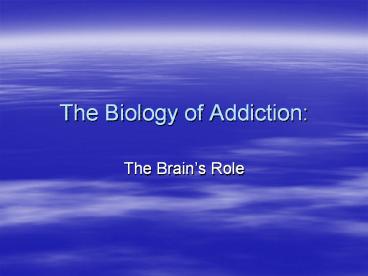The Biology of Addiction: - PowerPoint PPT Presentation
1 / 13
Title:
The Biology of Addiction:
Description:
Transforms environmental stimulation into electrical impulses for the mind to ... and increase the production of dopamine powerful feeling of euphoria/stamina ... – PowerPoint PPT presentation
Number of Views:43
Avg rating:3.0/5.0
Title: The Biology of Addiction:
1
The Biology of Addiction
- The Brains Role
2
The Brain
- Transforms environmental stimulation into
electrical impulses for the mind to interpret - Types of brain cells
- Glial cells support cells ? provide
nourishment and insulation - Neurons working cells ? generate and transmit
electrical impulses
3
Parts of Neuron
- Cell body life support centre
- Nucleus control centre
- Dendrites fingers receiving incoming signals
from other neurons - Myelin Sheath fatty membrane surrounding the
axon - Axon terminal buttons generating, storing,
and transporting signals to other neurons - Neurotransmitters chemical substances that
transmit electrical impulses across a synapse.
4
Neurotransmitters most involvedin addiction
- Dopamine ? master molecule
- increase sense of pleasure
- Related to
- Motor control
- Processing information
- Abstract thinking
- Excitement
5
- Serotonin ?
- Related to
- Mood regulation
- Emotionality
- Appetite
- Sleep patterns
- Sociability
6
- Endorphin ? secondary feel-good chemical
- Works with dopamine to increase pleasure
- Related to
- Relief of pain
- Sense of well-being
7
How drugs affect neurotransmitters
- Cocaine blocks the re-uptake of dopamine ? this
keeps the pleasure circuit firing ? burst of
energy/insight/alertness - Amphetamines block re-uptake and increase the
production of dopamine ? powerful feeling of
euphoria/stamina - Heroin increases dopamine and endorphin ? intense
rush followed by dream-like state - Alcohol increases level of all neurotransmitters
(including GABA) ? at first feel sociable,
disinhibited, and then later sleepy
8
Chemical Tolerance
- Chronic use of any drug reduces the number of
dopamine producers and receivers. Thus pleasure
circuit calms down and requires higher levels of
drug to get high - Less efficient pleasure circuit also means
feelings of depression occur when drug not
present - Abstinence allows dopamine receptors to
eventually return to normal
9
Chemical Imbalances
- Certain individuals are born with an imbalance of
neurotransmitters, making them genetically
predisposed to addiction - These persons often exhibit attention problems
and sleep disorders (and sometimes, general
antisociality) during childhood - People who compulsively seek novelty also tend to
abuse drugs ? novelty seeking seems to be genetic
10
Genetic Contributions to Addiction
- Points to remember
- Parents pass on both genes and experience
- Genes influence absorption, metabolism,
excretion, receptor sensitivity, etc. - Psychologists make certain assumptions on the
basis of adoption studies
11
Early Findings (prior to 1990)
- 1/3 of alcohol abusers have at least one parent
who is alcoholic - Children of alcoholics show increased risk of
developing alcoholism even when adopted at birth
by non-alcoholic parents - Those with alcoholic parents have an earlier
onset of abuse, increased severity of symptoms,
and greater number of legal and medical
complications attributable to abuse
12
More recent research (1995)
- Sons of alcoholics have reduced sensitivity to
alcohol. Those most insensitive were most likely
to be diagnosed as alcohol dependent - Presence of tolerance seems to predict the
development of alcoholism even in subjects
without a family history of alcoholism - May cause physical dependence to precede
psychological dependence
13
- Identification of the gene for alcoholism ?
discovery made by postmortem results - The opposite influence can also be inherited ?
less effective metabolizing ? facial flushing ?
probability of becoming alcohol dependent is
reduced







![[PDF] The Book of Ethics: Expert Guidance For Professionals Who Treat Addiction Kindle Edition Ipad PowerPoint PPT Presentation](https://s3.amazonaws.com/images.powershow.com/10105900.th0.jpg?_=20240823045)























